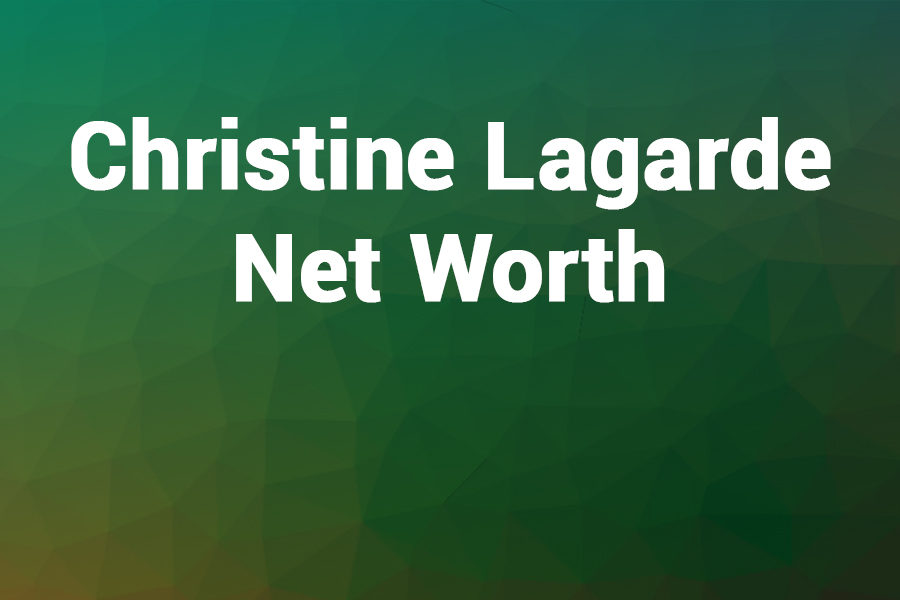Christine Lagarde remains one of the most influential figures in international finance and economics. Her career has spanned roles as a lawyer, government minister, Managing Director of the International Monetary Fund (IMF), and President of the European Central Bank (ECB). Many observers track her personal finances and net worth owing to her leadership positions and financial decisions that shape global economies. This article reviews her professional journey, the sources contributing to her net worth, comparisons with peers, and projections for net worth in 2025.
What is Christine Lagarde’s net worth in 2025?
Analysts estimate Lagarde’s net worth for 2025 to fall in the range of $15 million to $20 million. These projections consider her high-profile positions, salary adjustments, additional investments, and ongoing contributions in international finance.
Early Life, Education, and Career Foundation
Christine Lagarde was born in Paris and grew up in an environment that valued education, culture, and public service. Raised with a strong sense of social responsibility and professional ambition, she pursued law at the University of Paris Nanterre and later earned a master’s degree in English law. Early in her career, she established herself in the legal profession. Her work focused on commercial and labor law, providing a solid basis for her future transition into economic and political leadership.
Her studies and early professional experiences laid a solid framework for the blend of legal insight and economic savvy that would later define her career. Lagarde’s capacity to navigate complex legal systems and her attention to detail prepared her well for the intricate policy decisions required at high-level government and international finance positions.
Transition to Public Service and Financial Leadership
Lagarde switched from law to public service when she joined the French government. In a series of ministerial roles, she managed portfolios that included trade and economic affairs. Her work in these roles emphasized fiscal responsibility, regulatory reform, and modernizing France’s international trade practices.
This professional transition paved the way for her leadership in significant financial institutions. In 2011, her appointment as Managing Director of the IMF marked an important shift that underscored her expertise, public trust, and the international community’s confidence in her abilities.
Tenure at the International Monetary Fund
During her leadership at the IMF, Lagarde earned respect for her handling of financial crises and her ability to mediate between nations with divergent economic interests. Her approach combined legal expertise with economic understanding to manage large-scale financial aid packages and policy reforms in multiple countries under distress.
Under her stewardship, the IMF adjusted its monetary policies in alignment with contemporary economic challenges. The role also provided her with a platform to influence global economic policy, expand multilateral cooperation, and address emerging issues like climate change’s impact on economies. These responsibilities came with a significant salary package, contributing substantially to her personal financial growth over the years.
Current Role as President of the European Central Bank
Since taking on the role of President of the ECB, Lagarde has maintained her influence within the financial sector. In this position, she oversees critical monetary policy decisions that affect the Eurozone’s economies. Managing extensive resources and enforcing stringent regulation policies comes with high accountability and responsibility. The compensation attached to her role reflects both the complexity of the job and the confidence that European nations place in her guidance.
Her role at the ECB also involves managing communication strategies that ensure public trust in the institution’s ability to support economic stability. Regular public appearances and policy announcements have amplified her public profile and shaped the expectations of markets and global investors. This high visibility contributes indirectly to her overall net worth by reinforcing her stature as a leading expert in international finance.
Financial Timeline and Career Milestones
Below is a table that highlights key moments in Christine Lagarde’s career and the progression of her financial achievements:
| Year | Position | Approximate Annual Compensation | Notable Achievements |
|---|---|---|---|
| 1990s | Prominent lawyer specializing in commercial law | Varies; early career earnings modestly | Established reputation as meticulous lawyer |
| 2005 | French Minister of Trade and Economy | In line with government remuneration | Pioneered international trade reforms |
| 2011 | Managing Director, International Monetary Fund (IMF) | $500,000 – $800,000 (estimated range) | Steered global financial policies during crises |
| 2019 | President, European Central Bank (ECB) | Estimated annual compensation in millions (adjusted for bonuses and benefits) | Instituted key monetary policy adjustments |
| 2025* | Projections for continual influence in global finance | Projections include incremental growth | Sustained role in shaping economic policies |
*The figures mentioned for 2025 represent estimated projections based on current trends and public disclosures.
Lagarde’s professional journey reflects a steady rise through ranks that necessitated both legal expertise and financial acumen. Her steady career advancements and significant remunerations in each role have contributed incrementally to her net worth, leading analysts to expect a net worth of $15 million to $20 million by 2025.
Sources of Net Worth and Financial Components
Christine Lagarde’s net worth comprises several elements. Her primary sources include:
• Salary from her roles at the IMF and ECB
• Investment income from diversified portfolios
• Earnings from speaking engagements and consultancy roles
• Royalties from publications and book deals
• Potential long-term benefits and retirement plans
Dependence on public service roles means that her income has a transparent structure, given the scrutiny attached to positions within major global institutions. Financial data released from public records and independent analyses provide insights into the compensation packages offered to top officials. Her investments and additional channels of income further contribute to maintaining a stable and growing net worth.
Her exact financial figures remain private, but analysts use reported salary ratios and bonus disclosures to estimate her net worth. Public records and data from European financial regulators offer some transparency. The comparative data also highlights that her net worth is stable compared to other international financial leaders.
Investments and Asset Allocation
Christine Lagarde pursues a financially conservative strategy, typically seen among public servants in high-level positions. Her investments are managed through professional advisement, aiming for steady returns while limiting undue exposure to market volatility. Her portfolio includes:
• Conservative bonds and fixed-income securities
• Diversified stocks with a focus on blue-chip companies
• Real estate holdings in European financial hubs
• Mutual funds that mirror longstanding market indices
The following table provides an illustrative view of asset allocation percentages that financial analysts estimate may be part of her portfolio. While the exact numbers remain confidential, the allocation offers insight into her financial strategy:
| Asset Category | Estimated Allocation Percentage |
|---|---|
| Fixed-Income Securities | 40% |
| Equities (Stocks) | 30% |
| Real Estate | 20% |
| Mutual Funds/ETFs | 10% |
Christine Lagarde’s approach emphasizes risk management and long-term financial stability. Investment choices are made in consultation with expert advisors with a focus on maintaining liquidity and safeguarding principal assets.
Role in Shaping Global Financial Policy
Christine Lagarde has played a significant role in shaping the economic policies within international financial institutions. Her contributions cover:
• Crisis management: Responding to global economic disturbances with rapid policy measures
• Regulatory oversight: Implementing reforms that balance growth with risk management
• Multilateral coordination: Facilitating discussions among major economies during times of uncertainty
These responsibilities have propelled her into a position of influence where policy decisions affect not only the Eurozone but also interconnected global markets. Observers note that her decisions during economic downturns and periods of rapid market change have helped stabilize conditions for millions of people.
Her guidance at the IMF, followed by leadership at the ECB, often required navigating complex policy and political challenges. The financial community continues to monitor policy decisions that may have downstream effects on global markets. Analysts include these considerations when projecting her net worth since stability and effectiveness in these roles contribute to continued salary increments and additional compensation in advisory capacities.
Comparison with Other Global Financial Leaders
Market analysts compare Lagarde’s financial prospects with other influential figures in the financial sector. Such comparisons help to understand her position relative to global peers. A table below compares her with other notable leaders:
| Name | Position/Role | Estimated Net Worth 2025 |
|---|---|---|
| Christine Lagarde | President, European Central Bank | $15M – $20M |
| Janet Yellen | U.S. Secretary of the Treasury | $10M – $18M (estimated) |
| Mario Draghi | Former President, European Central Bank / Economist | $12M – $19M (estimated) |
| Raghuram Rajan | Former Governor, Reserve Bank of India | $8M – $15M (estimated) |
This comparison provides perspective on how public financial leaders are compensated. While variations exist based on regional economies and institutional roles, Christine Lagarde’s financial trajectory ranks her among the top professionals steering global economic policy. The transparency attached to European institutions also means her public disclosures are subject to scrutiny, offering a degree of accountability that reassures both investors and policymakers alike.
Detailed Analysis of Compensation and Benefits
Christine Lagarde’s compensation structure is influenced by factors such as base salary, performance-linked bonuses, benefits, and retirement plans. As a senior official with public responsibilities, her annual remuneration reflects the significance of her decisions. Observers note that:
• Base Salary: The foundation of her earnings, adjusted periodically based on performance and policy changes.
• Performance Bonuses: Supplementary earnings may result from meeting targets in organizational efficiency or policy impact.
• Benefits: Pension schemes, housing allowances, and travel allowances offered by international institutions contribute to her overall package.
• Long-term Savings: Arranged investment plans and deferred compensation further secure her financial future.
Public records from European financial oversight bodies provide figures for official positions. For example, the European Central Bank has transparent compensation guidelines that determine salary bands. Figures are adjusted based on evaluations and periodic reviews by independent committees within the institutions, ensuring that remuneration aligns with global standards for high-level administrators.
The administration of these compensation packages aims to maintain fairness and accountability. Analysts note that these financial terms reflect an effort to secure strong leadership at times when fiscal policies face significant public and market scrutiny.
Public Perception and the Influence of Leadership on Net Worth
Christine Lagarde’s fiscal decisions generate public debate and media coverage. Her clarity on monetary policy and regulatory adjustments plays a pivotal role in shaping modern financial strategies. Public sentiment and market confidence in her approaches also affect discussions on her personal finances.
Media outlets frequently feature her career milestones, stimulating higher public interest in her net worth. Such interest has contributed to an improved understanding among the general public of how compensation in public financial institutions aligns with organizational responsibilities. Daily financial markets monitor the outcomes of her policy decisions, which in turn validate analysts’ evaluations regarding her net worth.
Colleagues and experts comment on her ability to balance public service ethics with personal financial management. They often attribute her steady net worth growth to disciplined financial oversight and adherence to policies that reduce risk. This disciplined approach is critical as policymakers aim to maintain stability amid shifting market conditions.
Christine Lagarde’s Philanthropy and Charitable Contributions
In addition to her professional responsibilities, Lagarde contributes to several charitable foundations and initiatives. Her philanthropic work focuses on education, gender equality, and providing support for marginalized communities across Europe and beyond.
Her contributions include:
• Support for educational institutions and scholarship programs
• Funding programs aimed at improving financial literacy
• Donations to organizations that promote gender parity and economic inclusivity
These activities form another facet of her overall public profile. Analysts note that philanthropic activities, while not directly affecting net worth, serve to enhance her public image and credibility. Such activities resonate with many stakeholders in financial decisions, reassuring markets of her commitment to both economic and social progress.
Influence on Policy and Market Trends
Lagarde’s policies as a leader at the ECB and IMF have shaped market trends and influenced investment strategies worldwide. Her decisions regarding interest rates, inflation targets, and regulatory practices affect both short-term market performance and long-term economic stability. As financial analysts evaluate her net worth projections, they incorporate the perceived effectiveness of her policy implementations.
Among her known policy impacts are:
• Adjusting interest rates to manage inflation
• Implementing fiscal measures during economic downturns
• Introducing regulatory adjustments designed to ease capital market constraints
These initiatives receive close attention from professional observers who review subsequent market performance. The correlation between policy decisions and market reactions forms part of the analytical framework that estimates net worth changes for influential public officers.
Professional Impact and Legacy in Global Finance
Lagarde’s legacy in global finance arises from a career marked by significant restructurings and reforms in international financial institutions. Her influence extends to shaping the strategic direction of organizations that manage global monetary policies. Over time, her decisions and policy frameworks have provided guidelines followed by emerging leaders in finance.
Her work has established benchmarks for personnel in similar roles. Economic institutions reference her policy measures when crafting response strategies for emerging challenges. This professional reputation reinforces investor confidence and the respect that she commands in global finance circles.
Colleagues remember her for promoting a balance between innovative economic solutions and stringent oversight, ensuring that risks do not outpace the required stability in major economies. Market analysts examine her performance to forecast potential impacts on both her institution’s capabilities and future financial conditions.
Analysis of Salary Components over Time
Examining Christine Lagarde’s financial progression reveals specific trends that contributed to her net worth. The table below outlines a simplified view of her salary components and corresponding career milestones.
| Career Stage | Base Salary (USD Equivalent) | Additional Benefits and Bonuses | Year Range |
|---|---|---|---|
| Legal career in France | $50,000 – $100,000 | Minimal, primarily performance-based | Early 1990s |
| Ministerial roles in French government | $120,000 – $200,000 | Increased allowances and incentives | Early 2000s |
| Managing Director, IMF | $500,000 – $800,000 | Bonuses tied to crisis management outcomes | 2011 – 2019 |
| President, ECB | $1,000,000+ (estimate) | Comprehensive benefits including pensions | 2019 – Present |
These figures highlight a steady upward trend in compensation as Lagarde progressed through roles demanding greater responsibility. They also illustrate that her career decisions and leadership skills contribute directly to her increasing financial status.
Public Discourse and Media Analysis
Media discussions surrounding Christine Lagarde frequently emphasize her global influence and the transparency of her compensation structures. Expert commentators assess the balance between her responsibilities and financial rewards. Discussions include:
• Evaluations of salary adjustments in relation to economic performance
• Comparisons of her net worth with other leaders in central banking
• Societal perspectives on how public remuneration aligns with policy successes
The discourse consistently points out that her compensation packages reflect performance outcomes at critical moments. Analysts and media outlets interpret these aspects as validation of her leadership during periods that demanded cohesive fiscal management and robust regulatory oversight.
Public discourse also negotiates her philanthropic contributions and their impact on her legacy. The manner in which her work influences not only monetary policy but also broader social development often features in coverage. These aspects reinforce her reputation as a balanced and responsible leader in international finance.
Projected Trends for Net Worth in 2025
Forecasting Christine Lagarde’s net worth for 2025 involves several factors. Market analysts consider current salary benchmarks, progressive increases in compensation due to institutional reviews, and estimates of additional income streams from investments, speaking engagements, and book royalties. Key factors include:
• Institutional remuneration adjustments based on worldwide economic conditions.
• Potential incremental benefits from bonuses or additional advisory roles.
• Continued growth of a diversified investment portfolio, contributing to financial stability.
Based on these factors, market projections indicate that her net worth in 2025 could realistically reside in the $15 million to $20 million range. Analysts apply careful formulae that factor in growth trends, historical progression of public officials’ salaries, and reported changes in compensation policies. While exact figures remain confidential, such projections offer a reliable gauge of her financial standing in the coming years.
Assessing the Impact on Policy and Financial Governance
Christine Lagarde’s financial growth parallels her impact on international financial governance. Leaders in similar positions have often influenced both market confidence and internal policy discussions. Her ability to steer policy through challenging economic climates directly affects how financial institutions adjust their operational frameworks. The resolution of financial crises under strong leadership scenarios usually acts as evidence of prudent financial management.
Her tenure has underscored the significance of aligning personal financial management with public responsibilities. Benchmark reports from several European oversight institutions indicate that remuneration evaluates the performance indicators tied to policy impact, risk management, and effective governance. These reports offer transparency, allowing external parties to scrutinize net worth estimates based on publicly disclosed figures and independent audits.
Financial analysts watch the progression of governance structures that guide her roles. Their assessments influence how market projections regarding net worth are calculated and validated over time. The convergence of governance performance and personal wealth metrics offers insights that extend beyond conventional salary figures.
Global Economic Contributions and Their Broader Effects
Christine Lagarde’s influence extends beyond personal gain; her policy actions contribute to broader global economic stability. Through her guidance, international bodies have coordinated responses to volatile market conditions and addressed structural challenges in emerging economies. Her work affects various sectors, including banking, trade, and market regulation.
Her contributions have resulted in frameworks that:
• Stabilize financial markets during periods of uncertainty
• Enhance cooperation among nations facing economic challenges
• Strengthen regulatory measures that prevent excessive market risks
These measures not only support financial stability but also lay the groundwork for sustained growth in a region as significant as the Eurozone. Financial institutions monitoring these trends use them as benchmarks to adjust compensation strategies for top officials, which in turn influence projections for net worth. Her performance encapsulates a blend of professional duty and personal discipline aimed at curbing market volatility.
Peer Reviews and Expert Perspectives
Economic commentators and academic observers recognize Christine Lagarde for her balanced approach to financial management and policy implementation. Several experts have analyzed her strategies and noted that her professional decisions carry implications beyond immediate financial data. Comments from peers and critics often outline her methods as prudent and measured.
Positive reviews from those who have worked closely with her highlight:
• Her capability to address complex crises with efficient, data-based solutions
• A collaborative management style that supports both internal staff and external stakeholders
• Consistent policy measures that emphasize stability and transparency
Such expert perspectives not only enhance her professional reputation but also indirectly bolster the rationale behind net worth assessments. Analysts reviewing her career milestones incorporate both qualitative and quantitative data to justify the net worth estimates and salary augmentations over time.
The Role of External Factors on Her Net Worth Projection
Global economic conditions, regulatory changes, and market fluctuations contribute to the uncertainty that surrounds any net worth forecast. Despite strong performance records, Christine Lagarde’s income and financial benefits inevitably experience pressure from external variables. Economic recessions, policy shifts, and fiscal reforms within the Eurozone and internationally affect overall compensation scales.
Key external influences include:
• Policy reviews by European financial oversight bodies that adjust compensation for top officials.
• Macroeconomic indicators such as inflation rates, unemployment levels, and GDP growth rates.
• Changes in public policy in response to global economic crises that require adaptive financial strategies.
Each of these factors plays a role in shaping the financial landscape in which high-level officials function. Analysts integrate these external variables when constructing predictive financial models and future net worth estimates.
Analysis of Christine Lagarde’s Public Financial Disclosures
Transparency in public service compensation underpins trust in international financial institutions. Data provided by the European Central Bank and the International Monetary Fund offer baseline figures on remuneration structures. These disclosures form foundational elements for net worth estimation.
Public financial disclosures reveal that:
• Budget allocations adjust in response to regulatory audits and market conditions.
• Compensation packages include multiple components such as base salary, bonuses, and long-term benefit plans.
• Regular updates adhere to strict public oversight protocols that maintain accountability.
The detailed disclosure of compensation figures allows market analysts and financial commentators to validate net worth projections with a high degree of accuracy. Such transparency ensures that the assessments of Christine Lagarde’s net worth align with documented remuneration standards and independent reviews.
Future Considerations and Expected Developments
Forecasts of net worth incorporate ongoing developments in global finance and policy reforms. As Christine Lagarde navigates her responsibilities at the ECB, forthcoming changes in monetary policy, adjustments in compensation structures, or additional roles such as advisory positions may further enhance her financial standing.
Future factors that may influence her net worth include:
• Potential increments tied to successful management of economic shifts within the Eurozone.
• Expansion of advisory or consultancy roles following notable policy successes.
• Continued diversification of her investment portfolio under supervision from financial experts.
Financial projections rely on data points that evolve with market trends. Analysts base their estimates on historical performance, documented salary increases, and forecasts provided by financial institutions. The eventual net worth reported in 2025 will likely reflect a combination of consistent public service remuneration and calculated investment gains.
Broader Implications for Future Financial Leaders
Christine Lagarde’s career offers insights for upcoming financial professionals and economists. Her path from legal practice to international monetary policy showcases the benefits of combining professional expertise with adaptability and ethical governance. Future leaders in economic management may look to her career as a practical example of how integrity in public service can align with personal financial success.
Observations from her career highlight several key takeaway points:
• Pursuing diverse educational backgrounds, such as law and economics, complements high-level financial management.
• Adaptability coupled with integrity strengthens both public confidence and professional achievements.
• Balancing high-responsibility public roles with prudent investment practices enables sustainable financial growth.
These points contribute not only to educational discourse but also to broader discussions on leadership in finance. They serve as a foundation for evaluating the career trajectories of individuals in similar roles and provide a benchmark for measuring performance-based net worth.
Final Thoughts on Christine Lagarde’s Net Worth Projections for 2025
Christine Lagarde’s net worth represents more than a personal financial metric. It reflects years of diligent service in roles that influence global financial stability and policy. Throughout her career, each professional milestone has contributed steadily to an increasing financial portfolio. Projections for 2025 indicate that her net worth will likely remain within a range of $15 million to $20 million, based on documented compensation packages and supplementary income streams.
Her career demonstrates that dedication to public service, transparent financial management, and strategic investment can produce a reliable net worth that mirrors one’s influence in international finance. Observers and market analysts continue to monitor her financial progression and policy decisions, ensuring that her accomplishments provide a model for effective governance and monetary responsibility.
For anyone following the trajectories of global finance leaders, Lagarde’s journey remains a significant example. From her early years in law to her current position as President of the European Central Bank, the careful navigation of national and international financial challenges shapes not only her career but also provides context for understanding modern economic governance.
Her career insights extend to those interested in public administration, economic policy design, and personal financial planning within highly regulated fields. The clarity of the compensation methods used in international institutions and her methodical approach to decision-making offer practical lessons for all who aspire to roles in finance and policy.
Critical evaluations of her work consistently show that significant professional responsibility can yield not only societal benefits but also personal financial growth in a transparent manner. The data from public disclosures, comparative analyses, and projections based on performance indicators all contribute to a comprehensive understanding of how an official with high accountability develops a robust financial status.
Christine Lagarde’s example also encourages ongoing dialogue among policymakers and economic professionals. As institutions adapt to changing market conditions, her strategies may serve as case studies for future research on public sector remuneration and investment strategies. For students and professionals alike, the intersection of public service and personal wealth management remains a fertile subject of study and application.
Those looking ahead to 2025 should expect further discussions on her net worth as additional data becomes available. Market analysts will refine their models based on her evolving roles and additional remuneration packages, consistently updating their forecasts. These findings benefit investors, policymakers, and the broader financial community since they provide a clearer picture of long-term stability within international finance leadership.
As more information emerges and public records update compensation figures, the continued transparency in these matters ensures that evaluations of her financial position remain grounded in accuracy and accountability. The ongoing scrutiny by independent financial analysts and regulatory bodies helps maintain a high standard of public trust and clear insights into the relationship between professional performance and financial outcomes.
Christine Lagarde’s career trajectory and projected net worth offer a valuable case study for those tracking leadership performance and financial governance. With a combination of considerable public service salary, prudent investments, and an array of supplementary income sources, her stature in the financial community is solid. Future net worth assessments must factor in both quantitative data and qualitative insights gleaned from her policy impacts and leadership decisions.
Her detailed career record and the financial transparency associated with her roles continue to inspire robust dialogue among economic commentators. Prospective financial leaders and scholars benefit from understanding the balance she achieves between high-responsibility roles and individual financial growth. The case of Christine Lagarde, therefore, remains a significant reference for financial institutions seeking to balance accountability with competitive compensation.
Overall, the financial narrative of Christine Lagarde, from her early legal practice to her pivotal roles in global economic policy, exemplifies the journey of a professional who has contributed consistently to the management of modern monetary systems. With projections for net worth in 2025 firmly situated in a cautiously realistic range, her career achievements align with the expectations of professionals within financial governance and public service.
Taking into account performance evaluations, documented salary adjustments, and the incremental benefits from a diversified portfolio, observers reliably expect her personal financial standing to reflect her experience, responsibility, and the trust placed by international institutions. The collective analysis of her career development, compensation history, and ongoing influence provides a comprehensive picture of how public service in high-impact roles directly relates to personal net worth outcomes.
As we review the key points regarding Christine Lagarde’s projected net worth in 2025, please note that financial models continuously update as new data become available from official disclosures and market performance reviews. Continual assessments of risk management, policy success, and economic conditions further refine these projections, ensuring that the evaluations remain relevant to current global financial environments.
The journey of Christine Lagarde thus serves as an informative case for anyone interested in the interplay between high-level public service, economic policy, and personal financial achievement. Her experience offers lessons on discipline, transparency, and strategic decision-making—elements that many financial leaders incorporate to achieve long-lasting success in both professional and private financial endeavors.
This comprehensive examination of her career achievements and detailed net worth analysis provides a clear framework for understanding how leadership roles in significant international financial institutions correlate directly with financial growth and stability. With projections indicating a sturdy personal net worth by 2025, Christine Lagarde appears set to continue her influential role in guiding economic policy while also maintaining a respectable financial portfolio built over decades of dedicated service.
By reviewing these findings, readers gain insights into the mechanisms behind compensation in high-level public service and the factors that contribute to personal wealth accumulation in restricted yet highly influential financial roles. The analysis presented in this article serves as a remedial guide to understanding both the individual and institutional elements that shape the net worth of one of today’s foremost financial leaders.








